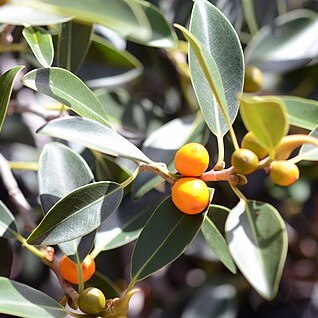Tree up to 15 m tall, terrestrial or hemi-epiphytic. Leafy twigs 2-4 mm thick, angular, glabrous or minutely white puberulous; periderm usually flaking off. Leaves spirally arranged; lamina oblong to (broadly) elliptic to (sub)ovate, 2.5-13 by 1.5-6.5 cm, coriaceous, apex short-acuminate to subacute or to obtuse, base cuneate to rounded (to subcordate), sometimes slightly attenuate, margin glabrous or minutely puberulous; upper surface sparsely minutely puberulous, mainly on the midrib, or glabrous, lower surface sparsely minutely puberulous on the veins or glabrous, sometimes ± clearly tessellate; cystoliths on both sides, only beneath or absent; lateral veins 8-16 pairs, the basal one slightly or hardly distinct, tertiary venation parallel to the lateral veins; waxy gland at the base of the midrib (often faint); petiole 0.2-0.8 or (1.5-)3-6 cm long, minutely puberulous or glabrous; stipules 1-2(-3) cm long, minutely white puberulous or glabrous, caducous. Figs axillary or just below the leaves, in pairs or solitary; peduncle 0.1-0.2 or 0.2-0.5(-0.8) cm long, the apex ± dilated; basal bracts 3, 2(-5?) mm long, early caducous; receptacle subglobose, 0.4-1.2 cm diam. when dry, sparsely minutely white puberulous or glabrous, at maturity yellow to red, apex slightly umbonate, ostiole tri-radiate; inner layer of the wall thin. Fruits not embedded in the wall.
More
A fig. It can be a straggling shrub or a dense spreading tree 10 m tall. The leaves are 5-6 cm long by 2-3 cm wide. The twigs produce milky sap. The leafy twigs are hairy. The male flowers are spread among the fruitlets of the ripe figs. The figs are small and gritty. They are 6-10 mm long by 6-10 mm wide.
Pending. See Ficus brachypoda in FloraNT (accessed 12 January 2022); also see Dixon (2011) and Ficus brachypoda in Zich et al. (2020).
A lithophyte, commonly found on outcrops of sandstone, limestone, quartz, granite, and occasionally basalt and laterite (Dixon 2011: 10); grows in monsoon forest and dry scrub (Zich et al. 2020); rocky sites, screes, creek beds, along drainage lines (W.A. FloraBase, accessed 12 January 2022).
More
It is a tropical plant. It grows in cracks in rocky outcrops in the dry rainforest in northern Australia. It can grow in deserts. It grows from sea level to 250 m above sea level.


